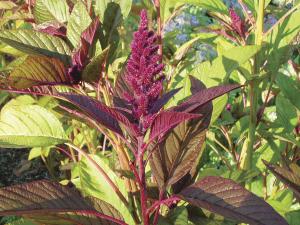Amaranth attracts bees, butterflies and birds
Every plant carries with it a rich history that spans cultures and stretches back across thousands of years.
As gardeners and farmers choose seeds from the best crops after several generations, this process of seed saving creates our modern crops.
The Hopi Indians of what is now the southwestern United States grow komo, a crop that came to them through trade. First domesticated around 4,000 BC in Mexico’s Tehuacan Valley, it is very nutritious, with edible leaves and tiny seeds that can be popped or eaten as a grain.
As this amaranth matures, the leaves darken to a mahogany red with showy blossoms that yield nutritious black seeds. The dark leaves are used to dye wool. Add Hopi Red Dye Amaranth to cut flower arrangements, where the stems will soon color the water a luxurious purple, adding to the bouquet’s charm.
This deep red-colored amaranth is a vital ingredient in the traditional Hopi piki bread, a crisp cornmeal wafer cooked on a thin stone slab. The shocking pink flower bracts of komo are soaked overnight in water and then added to cornmeal the next day, creating a bright pink piki bread.
Hopi Red Dye Amaranth (Amaranthus cruentus) is a welcome garden plant because it is so very drought-tolerant. Because it does so well in the heat, it can provide fresh greens during hot weather when many other greens stop growing or turn bitter. This stately plant can reach six feet tall. The tender young leaves can be green or maroon. Use the leaves as you would spinach, which they resemble in taste. Try eating the young leaves raw in salads or on sandwiches. Steam them lightly like spinach or kale. Chop the leaves into spaghetti sauce, soups and stews. They can even go into meatballs and meatloaf.
You can pull the entire young plant or clip just a few leaves and let the rest grow. If you wait to pull the entire plant between seven and nine weeks, the iron content of the leaves doubles between the seventh and ninth week.
Many grow Hopi Red Dye Amaranth just for the tiny, nutritious seeds, which contain 20 percent protein. The seeds are so small that it takes 50,000 seeds to weigh an ounce. To harvest seeds, wait until seeds are mature and dry. Pull up the entire plant and hang it upside down in a warm, dry place such as a garage or cellar. When the seeds have dried completely, shake the seed heads into a paper bag. Store the seeds in jars or other airtight containers.
Because this plant will scatter seeds and self-sow freely, you can cut off the blossoms before they set seeds to keep out any volunteer seedlings next season
After all danger of frost has passed, plant the seeds just one-eighth to one-quarter inch deep. Try grouping three seeds every 18 inches in the row. Space rows a foot apart. The tiny seeds will sprout in five to 15 days. When the plants reach an inch high, thin to six inches to 12 inches apart. It will grow in nearly any soil but prefers soil pH from 6.1 pH (mildly acidic) to 7.8 pH (mildly alkaline). You can transplant the seedlings around the garden. Many growers claim that amaranth needs to go through the shock of transplanting to speed up and improve the coloring of the leaves, which seems to be slow when direct seeding. Water sparingly, because too much moisture may kill them.
Hopi Red Dye Amaranth (Amaranthus cruentus) is available from Baker Creek Heirloom Seed Co., 2278 Baker Creek Road, Mansfield, MO 65704; phone: 417-924-8917 or Native Seeds Search, 584 E. River Road, Tucson, AZ 85718; phone: 520-622-0830 as well as others. Plan ahead and get seeds of Hopi Red Dye amaranth to plant in this year’s garden or around the flowerbeds. In addition to being a great food source, it attracts bees, butterflies and birds. You can eat the leaves and still collect the seeds. Make a colorful water from the stems to add to your very own pink Hopi piki cornbread. It is, after all, a favorite of the Hopi spirit or kachina, The Piki Eater, and you really do want the spirits on your side this garden year.






















































